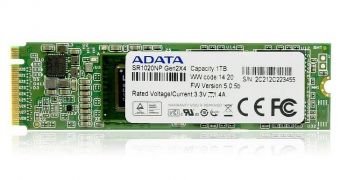Solid-state drives have really come a long way since they first took off a few years ago, and ADATA's flagship M.2 model proves it. Or, well, will prove it once it goes up for sale next month, June 2014.
Saying that SSDs “took off” might be a big of a stretch. Unlike other technologies, NAND Flash had to slowly work its way up instead of performing a great leap.
It's because, at first, capacity for SSDs was far too low compared to HDDs, while prices were higher than for even the lowest-space, least expensive hard drives.
SSDs still cost a lot more than HDDs, but only two or three times instead of a dozen times more. Besides, they also come in really small packages now.
And we're not referring to the 2.5-inch form factor either, but the M.2 shape, the latest and pretty much best format that such storage units ever came in.
After all, it takes a special kind of awesome for one whole terabyte to be stored on a metal slab as long and as wide as two of your fingers.
Because that's what the M/2 form factor is like, or NGFF (next-generation form factor) as it is otherwise known: small and thin.
It's actually somewhat startling that desktop motherboard makers are advertising it as a key feature, given that the size makes it better suited for laptops.
Then again, there's no way people won't like the idea of having 1 TB of SSD storage without any of the SATA ports getting occupied.
That's the top capacity you see, of the ADATA SR1020NP, and the performance is pretty amazing too, at 1.8 GB/s. More than three times what SATA SSDs can do (up to 550-560 MB/s).
An LSI-SandForce 3700 series controller is used, unsurprisingly. SandForce is the poster boy for super-fast solid-state drives after all.
Of course, the PCI Express 2.0 x4 interface was a key as well. There's no way that throughput would be possible on an interface with smaller bandwidth.
Alas, that's also a problem: most motherboards with M.2 support have PCI Express x2 slots for M.2, so you won't see that nice 1.8 GB/s speed any time soon. Hopefully, some new gaming-grade mainboards will come out at Computex 2014 (June 3-7). Since DDR4 is slated to come out at the same time, we have high hopes.
There is one motherboard that can handle the strain though: ASRock Z97 Extreme 6. Alas, populating the x4 M.2 slot will cause the PCI Express x16 graphics slot to work at x8 mode, because of a performance bottleneck (the interface is wired to the CPU root complex, as certain people like to remind everyone).

 14 DAY TRIAL //
14 DAY TRIAL //